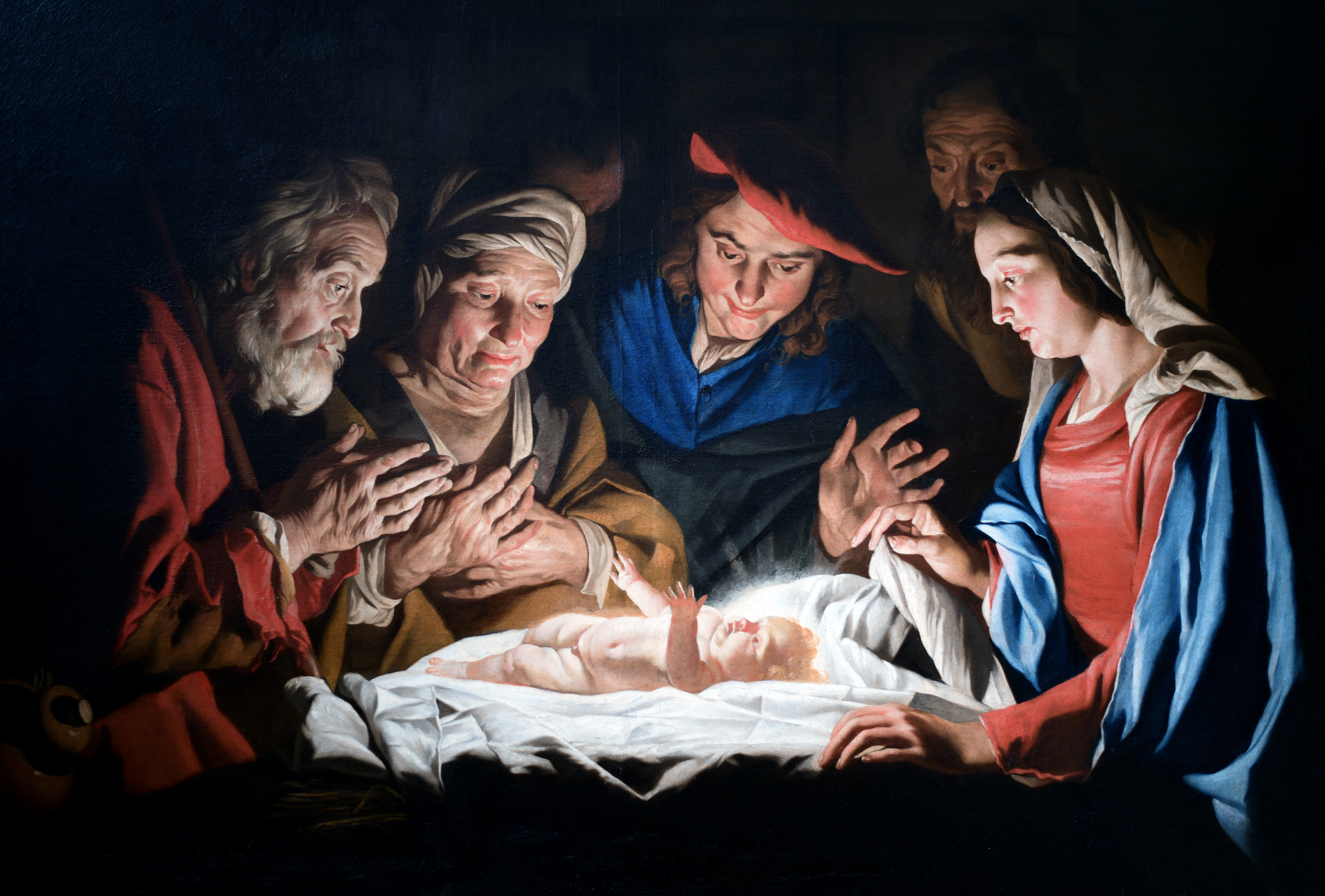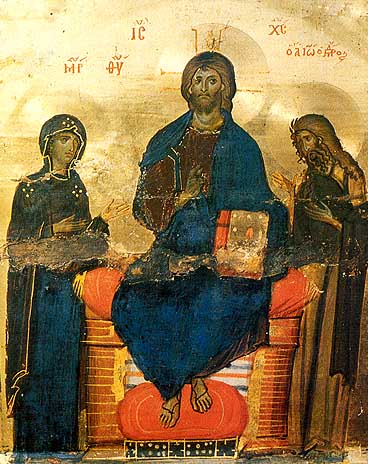|
Lagurka
The Kala church of Saints Cyricus and Julitta ( ka, ßāÖßāÉßāÜßāÉßāĪ ßā¼ßāøßāśßā£ßāōßāÉ ßāÖßāĢßāśßāĀßāśßāÖßāößāĪßāÉ ßāōßāÉ ßāśßāĢßāÜßāśßāóßāÉßāĪ ßāĪßāÉßā«ßāößāÜßāØßāæßāśßāĪ ßāößāÖßāÜßāößāĪßāśßāÉ, tr), locally known as Lagurka (ßāÜßāÉßāÆßāŻßāĀßāÖßāÉ), is a medieval church in the Mestia Municipality in Georgia's region of Samegrelo-Zemo Svaneti. The area is part of the highland historical and cultural region of Upper Svaneti where Lagurka is regarded as the principal Christian shrine, its designation deriving from the name of Cyricus in the local Svan language. It is a hall church, adorned with frescoes painted by Tevdore in 1111/1112, one of the high points of medieval Georgian monumental art. The church is inscribed on the list of the Immovable Cultural Monuments of National Significance of Georgia. History Lagurka is nested on a high hill above the village of Khe in the Kala territorial unit, Mestia Municipality, on the left bank of the upper Enguri River, at about 2200 metres ab ... [...More Info...] [...Related Items...] OR: [Wikipedia] [Google] [Baidu] |
Immovable Cultural Monuments Of National Significance
The Immovable Cultural Monuments of National Significance ( ka, ßāößāĀßāØßāĢßā£ßāŻßāÜßāś ßāøßā£ßāśßā©ßāĢßā£ßāößāÜßāØßāæßāśßāĪ ßāÖßāÉßāóßāößāÆßāØßāĀßāśßāśßāĪ ßāÖßāŻßāÜßāóßāŻßāĀßāśßāĪ ßāŻßā½ßāĀßāÉßāĢßāś ßā½ßāößāÆßāÜßāößāæßāś) are buildings, structures, sites, or places in Georgia (country), Georgia that have been determined to have National heritage site, nationwide cultural significance by meeting special criteria developed by the Ministry of Culture and Sports of Georgia, Ministry of Culture and are subject to preservation by the state. The monument must have an outstanding artistic or aesthetic value, be associated with a particularly important historical event, person, or overall national values. The original list of the Immovable Monuments of Cultural Heritage was approved in the President of Georgia, Presidential decree No. 665 of 7 November 2006. Since then, it has been updated several times. After the amendments of 2013, the monument can be defined as having national significa ... [...More Info...] [...Related Items...] OR: [Wikipedia] [Google] [Baidu] |
Cyricus And Julitta
Cyricus ( el, ╬Ü╬«ŽüŽģ╬║╬┐Žé, am, ßēéßłŁßēåßłĄ, arc, ▄Ī▄¬▄Ø ▄®▄ś▄¬▄Ø▄®▄ś▄Ż ▄Ż▄Ś▄Ģ▄É ''Mar Quriaqos Sahada''; also Cyriacus, Quiriac, Quiricus, Cyr), and his mother, Julitta ( el, ß╝Ė╬┐Žģ╬╗╬»ŽäŽä╬▒, am, ßŖźßŗ©ßłēßīŻ arc, ▄Ø▄ś▄Ā▄Ø▄ø▄É, ''Yulitha''; also Julietta) are venerated as early Christian martyrs. According to tradition, they were put to death at Tarsus in AD 304. Cyricus Some evidence exists for an otherwise unknown child-martyr named Cyricus at Antioch. It is believed that the legends about Cyricus and Julitta refer to him. There are places named after Cyricus in Europe and the Middle East, but without the name Julitta attached. Cyricus is the Saint-Cyr found in many French toponyms, as well as in several named San Quirico in Italy. The cult of these saints was strong in France after Amator, Bishop of Auxerre, brought relics back from Antioch in the 4th century. It is said that Constantine I discovered their relics originally and built a monastery near Constanti ... [...More Info...] [...Related Items...] OR: [Wikipedia] [Google] [Baidu] |
Iprari Church
The Iprari church of the Archangels ( ka, ßāśßāżßāĀßāÉßāĀßāśßāĪ ßāøßāŚßāÉßāĢßāÉßāĀßāÉßā£ßāÆßāößāÜßāØßā¢ßāśßāĪ ßāößāÖßāÜßāößāĪßāśßāÉ, tr), or Tarngzel as it is locally known, is an 11th-century Georgian Orthodox church at the outskirts of Mestia in Upper Svaneti. Architecturally an unremarkable hall church, Iprari contains a set of frescoes painted by Tevdore in 1096, one of the high points of medieval Georgian monumental art. The church is inscribed on the list of the Immovable Cultural Monuments of National Significance of Georgia. Architecture Iprari is a small and simple rectangular edifice with the dimensions of 4.75 ├Ś 2.6 m2, ending in an apse to the east. The church is built of well-hewn yellowish pumice square blocks. Facades are simple, decoration-poor. The only entrance is located on the west. The interior is lit by two windows, one in the apse and the other above the entrance. The altar is separated from the hall by a stone altar screen, with three arched openi ... [...More Info...] [...Related Items...] OR: [Wikipedia] [Google] [Baidu] |
Apse
In architecture, an apse (plural apses; from Latin 'arch, vault' from Ancient Greek 'arch'; sometimes written apsis, plural apsides) is a semicircular recess covered with a hemispherical vault or semi-dome, also known as an '' exedra''. In Byzantine, Romanesque, and Gothic Christian church (including cathedral and abbey) architecture, the term is applied to a semi-circular or polygonal termination of the main building at the liturgical east end (where the altar is), regardless of the shape of the roof, which may be flat, sloping, domed, or hemispherical. Smaller apses are found elsewhere, especially in shrines. Definition An apse is a semicircular recess, often covered with a hemispherical vault. Commonly, the apse of a church, cathedral or basilica is the semicircular or polygonal termination to the choir or sanctuary, or sometimes at the end of an aisle. Smaller apses are sometimes built in other parts of the church, especially for reliquaries or shrines of ... [...More Info...] [...Related Items...] OR: [Wikipedia] [Google] [Baidu] |
Baptism Of Jesus
The baptism of Jesus by John the Baptist is a major event in the life of Jesus which is described in the three synoptic Gospels of the New Testament ( Matthew, Mark and Luke). It is considered to have taken place at Al-Maghtas (also called Bethany Beyond the Jordan), today located in Jordan. Modern biblical scholars view the baptism of Jesus as a historical event to which a high degree of certainty can be assigned. Along with the crucifixion of Jesus, biblical scholars view it as one of the two historically certain facts about him, and often use it as the starting point for the study of the historical Jesus. The baptism is one of the events in the narrative of the life of Jesus in the canonical Gospels; others include the Transfiguration, Crucifixion, Resurrection, and Ascension. The Gospel of John (John 1:28) specifies "Bethabara beyond Jordan", i.e., Bethany in Perea as the location where John was baptizing when Jesus began choosing disciples, and in John 3:23 there is ... [...More Info...] [...Related Items...] OR: [Wikipedia] [Google] [Baidu] |
Crucifixion Of Jesus
The crucifixion and death of Jesus occurred in 1st-century Judea, most likely in AD 30 or AD 33. It is described in the four canonical gospels, referred to in the New Testament epistles, attested to by other ancient sources, and considered an established historical event. There is no consensus among historians on the details.Christopher M. Tuckett in ''The Cambridge companion to Jesus'' edited by Markus N. A. Bockmuehl 2001 Cambridge Univ Press pp. 123ŌĆō124 In the canonical gospels, Jesus is arrested and tried by the Sanhedrin, and then by Pontius Pilate, who sentences him to flagellation and finally crucifixion by the Roman Empire.''The Cradle, the Cross, and the Crown: An Introduction to the New Testament'' by Andreas J. K├Čstenberger, L. Scott Kellum 2009 pp. 104ŌĆō108Evans, Craig A. (2001). ''Jesus and His Contemporaries: Comparative Studies'' p. 316 Jesus was stripped of his clothing and offered vinegar mixed with myrrh or gall (likely posca), t ... [...More Info...] [...Related Items...] OR: [Wikipedia] [Google] [Baidu] |
Nativity Of Jesus
The nativity of Jesus, nativity of Christ, birth of Jesus or birth of Christ is described in the biblical gospels of Luke and Matthew. The two accounts agree that Jesus was born in Bethlehem in Judaea, his mother Mary was engaged to a man named Joseph, who was descended from King David and was not his biological father, and that his birth was caused by divine intervention. Many modern scholars consider the birth narratives unhistorical because they are laced with theology and present two different accounts which cannot be harmonised into a single coherent narrative. But many others view the discussion of historicity as secondary, given that gospels were primarily written as theological documents rather than chronological timelines. The nativity is the basis for the Christian holiday of Christmas, and plays a major role in the Christian liturgical year. Many Christians traditionally display small manger scenes depicting the nativity in their homes, or attend nativit ... [...More Info...] [...Related Items...] OR: [Wikipedia] [Google] [Baidu] |
Christology
In Christianity, Christology (from the Greek grc, ╬¦Žü╬╣ŽāŽäŽīŽé, Khrist├│s, label=none and grc, -╬╗╬┐╬│╬»╬▒, -logia, label=none), translated literally from Greek as "the study of Christ", is a branch of theology that concerns Jesus. Different denominations have different opinions on questions like whether Jesus was human, divine, or both, and as a messiah what his role would be in the freeing of the Jewish people from foreign rulers or in the prophesied Kingdom of God, and in the salvation from what would otherwise be the consequences of sin. The earliest Christian writings gave several titles to Jesus, such as Son of Man, Son of God, Messiah, and , which were all derived from Hebrew scripture. These terms centered around two opposing themes, namely "Jesus as a preexistent figure who becomes human and then returns to God", versus adoptionism ŌĆō that Jesus was human who was "adopted" by God at his baptism, crucifixion, or resurrection. From the second to the fifth cen ... [...More Info...] [...Related Items...] OR: [Wikipedia] [Google] [Baidu] |
Deesis
In Byzantine art, and in later Eastern Orthodox art generally, the De├½sis or Deisis (, ; el, ╬┤╬Ł╬ĘŽā╬╣Žé, "prayer" or "supplication"), is a traditional iconic representation of Christ in Majesty or Christ Pantocrator: enthroned, carrying a book, and flanked by the Virgin Mary and St. John the Baptist, and sometimes other saints and angels. Mary and John, and any other figures, are shown facing towards Christ with their hands raised in supplication on behalf of humanity. Early examples often appeared on the templon beam in Orthodox churches or above doors, though icons and devotional ivories also feature the Deesis. After the development of the full iconostasis screen there was room for a larger "Deesis row" or "Great Deesis" of full-length figures, and the number of figures expanded, both in Byzantium and in Russia. Usually this row is above the level of the doors, and usually below (sometimes above) the row depicting the Twelve Great Feasts. The central Chris ... [...More Info...] [...Related Items...] OR: [Wikipedia] [Google] [Baidu] |
Conch (architecture)
In architecture, a semi-dome (or half-dome) is a half dome that covers a semi-circular area in a building. Architecture Semi-domes are a common feature of apses in Ancient Roman and traditional church architecture, and in mosques and iwans in Islamic architecture. A semi-dome, or the whole apse, may also be called a conch after the scallop shell often carved as decoration of the semi-dome (all shells were conches in Ancient Greek), though this is usually used for subsidiary semi-domes, rather than the one over the main apse. Small semi-domes have been often decorated in a shell shape from ancient times, as in Piero della Francesca's ''Throned Madonna with saints and Federigo da Montefeltro'', and the example in the gallery below. Islamic examples may use muqarnas decorative corbelling, while in Late Antique, Byzantine and medieval church architecture the semi-dome is the classic location for a focal mosaic, or later fresco. Found in many Ancient Greek exedras, the ... [...More Info...] [...Related Items...] OR: [Wikipedia] [Google] [Baidu] |
Aznauri
''Aznauri'' ( ka, ßāÉßā¢ßā£ßāÉßāŻßāĀßāś, ; pl. ''aznaurni'', ßāÉßā¢ßā£ßāÉßāŻßāĀßā£ßāś, or ''aznaurebi'', ßāÉßā¢ßā£ßāÉßāŻßāĀßāößāæßāś) was a class of Georgian nobility. The word derives from Middle Persian ''─üzn─üvar'', which, in turn, corresponds semantically to Middle Persian ''─üz─üd'' and Avestan ''─üz─üta-'' ("nobility"). The term is related to Pahlavi '' ─üz─üt-─ün'', "free" or "noble", who are listed as the lowest class of the free nobility in the Hajjiabad inscription of King Shapur I (240-270), and parallels to the '' azat'' of Armenia. It first appears in " The Martyrdom of Saint Shushanik", a 5th-century work of Georgian hagiographic literature. A later chronicle, that of Leonti Mroveli, derives "aznauri" from the semi-legendary ruler Azon (Georgian ŌĆō''uri'' is a common adjectival suffix), whose 1,000 soldiers defected him and were subsequently named aznauri by AzonŌĆÖs victorious rival Parnavaz. This etymology is patently false.Rapp, Stephen H. (2003), ''Studies I ... [...More Info...] [...Related Items...] OR: [Wikipedia] [Google] [Baidu] |









.jpg)